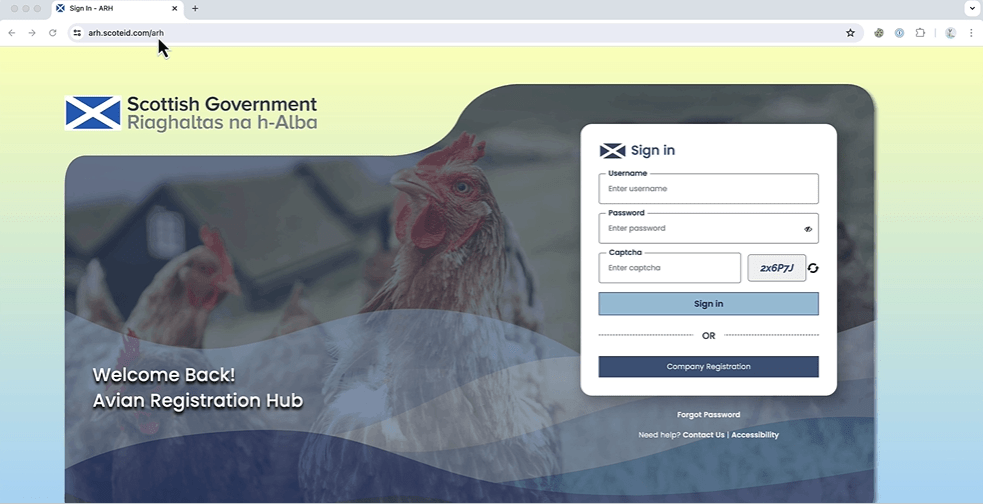Guidance
AVIAN REGISTRATION HUB – (ARH)
Every year, SG Poultry Branch registers and conducts inspections throughout Scotland across egg producers, hatcheries, breeders, rearers, free-range poultry meat, wholesalers, and egg packing centres. Our work is mandatory and driven by the need to comply with legislation to protect public health and animal welfare. Most of these are from business registration, approval letters, and Hen House Summary Certificates; inspection outcomes and non-compliance activity are all captured on SG Poultry Branch database GALLUS. Unfortunately, GALLUS (12 years old) was identified as being no longer fit for purpose for a number of reasons, including a lack of ability to make changes to meet evolving business and legislative requirements and old operating systems.
ARH is also part of the Programme for Government (PfG) 2023/2024, where it has committed to:
Develop our approach to future farming activity through engagement with key stakeholders to identify potential opportunities to increase sustainable production and markets for poultry and eggs, venison, and seed potatoes, and with young farmers to start work to design support options for new entrants (PfG); Deliver user-centered, efficient, and effective public-facing services in line with best practice by following the Digital Scotland Service Standard
The cloud-based ARH has been developed in conjunction with service partners (ScotEID and Triton Software), industry, and experienced development teams (internal and external). All businesses that were previously registered with the Scottish Government Animal Health & Welfare Poultry Branch (before 1 July 2024) had their details automatically migrated to the new database. The database went live on 1 July 2024.
As part of phase I, for the first time, registered poultry businesses will be able to check and update all of their own details, apply online for new registrations, and have access to their registration certificates (Hen House Summaries) and letters of registration. In phase II, the aim is for producers to be able to access outcomes from their inspections and then full inspection details.
The new ARH database has expanded on GALLUS to include all pullet rearing units and new sections covering salmonella testing, veterinary medicine residue testing, and implementing an earned recognition risk analysis to reward good practice and fully compliant inspection outcomes.
By modernizing the database, there will be a more flexible and intuitive reporting system that will dispense with the need for manual and time-consuming calculations, giving industry and government more space to focus on areas of concern or promotion of good practice and provide more meaningful and up-to-date statistics.
Not all poultry keepers have a requirement to register with ARH.
The requirements for registration are:
- You have 350 or more laying birds (not game, ducks, quail, or Guinea fowl). or
- You sell eggs (regardless of flock size) to retail/catering/wholesale establishmentsor
- If you send graded/ungraded eggs to a registered Egg Packing Centre or
- More than 50 birds and selling ungraded eggs at a local public market
If you have less than 350 birds and you're only selling at farm gates or private personal sales, you do not need to register with ARH, but you will need to register on SKBR.
If you wish to quality grade, stamp, label, and sell Class A eggs, there is an additional requirement to register as an Egg Packing Centre. Further guidance can be found through the link in guidance: RPS. Although it still appears that you can fill out a paper/electric application with ARH, this is not the case. This is part of the transitioning program, and these will be removed shortly. If you look at these application forms, they will give you an idea of the information that you need to fill out in an ARH egg packing centre or production unit application.
Poultry inspections (ruralpayments.org) Documents go into details of the range of requirements for egg packing centres, egg production units, and hatchery/breeder multipliers
- EMR1 (All about Egg Marketing Regulations)
- EMR9(All Hatching Eggs & Chicks) and
- EMR14 (All about Egg Production System, i.e., Free Range, Organic, Barn, and Enriched Cage)
Free Range Poultry Meat and Pullet Rearing Guidance Update Coming Soon
Production Unit (EMR3) - CPH number(Country Parish Holding) if you don't have one, you can apply for it when you reach that point in the application process.
Production Unit (EMR3) - Hen House names and numbers
Production Unit (EMR3) - Dates birds are to be housed
Production Unit (EMR3) - Numbers of birds delivered to each hen house
Production Unit (EMR3) - Maps: For free range (EMR3) and organic production of the land areas that will be used for range areas. You can attach copies to the application
Production Unit (EMR3)- Rental Agreements for areas of land that are rented and not owned. You can attach copies to the application
Production Unit (EMR3) - Tenant Agreements Please use the tenanted option (not rented); if you also rent land on a tenanted farm, include a rental agreement for this land
Production Unit (EMR3)- Accreditation Body (Organic only) name of the certification body and the approval number
Production Unit (EMR3) - Egg Packing Centre You will need the ID number and address of the EPC that will receive all ungraded eggs from your production unit.
Egg Packing Centre (EMR2) - A list of all production units sending in ungraded eggs to your egg packing centre
Egg Packing Centre (EMR2) - CPH number(Country Parish Holding) If you don't have one, you can apply for it when you reach that point in the application process.
Egg Packing Centre (EMR2) - Average weekly throughput of all eggs
Egg Packing Centre (EMR2) - A description of the packing centre structure, equipment, and machinery being used for weighing, stamping, and candling
